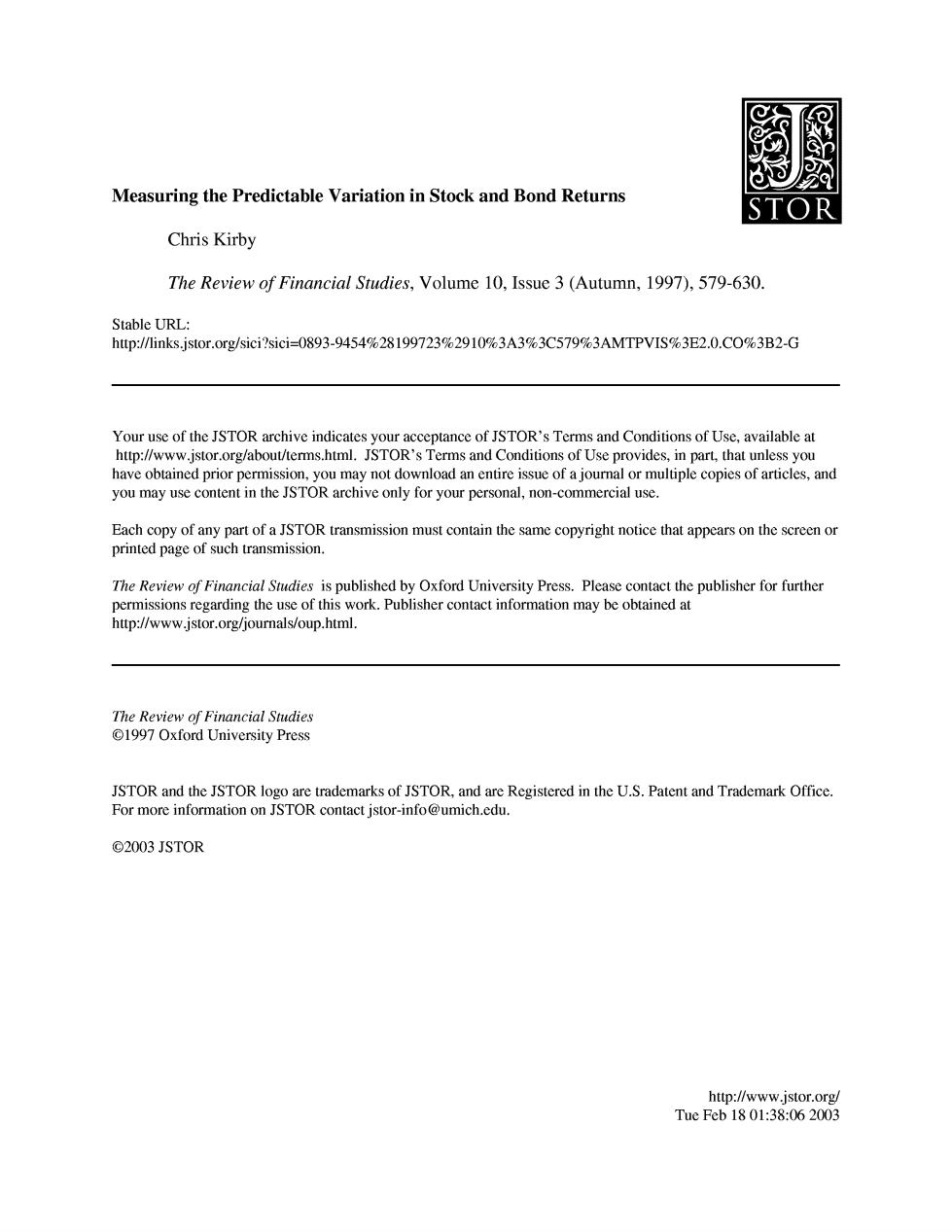
Measuring the Predictable Variation in Stock and Bond Returns T● Chris Kirby The Review of Financial Studies,Volume 10,Issue 3 (Autumn,1997).579-630. Stable URL: http://links.jstor.org/sici?sici=0893-9454%28199723%2910%3A3%3C579%3AMTPVIS%3E2.0.CO%3B2-G Your use of the JSTOR archive indicates your acceptance of JSTOR's Terms and Conditions of Use,available at http://www.jstor.org/about/terms.html.JSTOR's Terms and Conditions of Use provides,in part,that unless you have obtained prior permission,you may not download an entire issue of a journal or multiple copies of articles,and you may use content in the JSTOR archive only for your personal,non-commercial use. Each copy of any part of a JSTOR transmission must contain the same copyright notice that appears on the screen or printed page of such transmission. The Review of Financial Studies is published by Oxford University Press.Please contact the publisher for further permissions regarding the use of this work.Publisher contact information may be obtained at http://www.jstor.org/journals/oup.html. The Review of Financial Studies 1997 Oxford University Press JSTOR and the JSTOR logo are trademarks of JSTOR,and are Registered in the U.S.Patent and Trademark Office. For more information on JSTOR contact jstor-info@umich.edu. ©2003 JSTOR http://www.jstor.org/ Tue Feb1801:38:062003
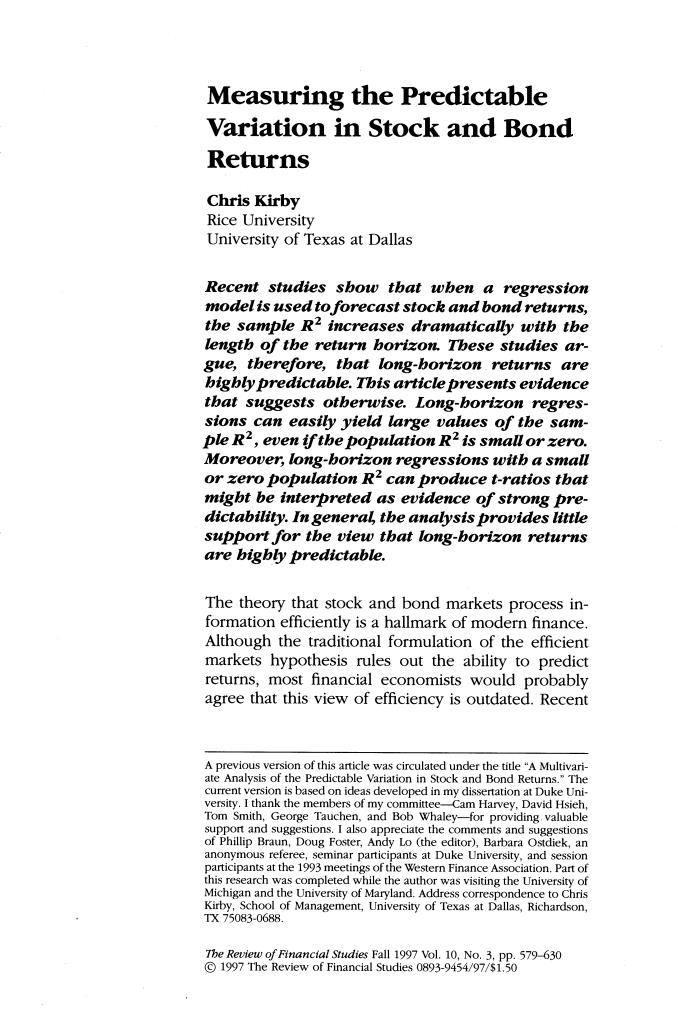
Measuring the Predictable Variation in Stock and Bond Returns Chris Kirby Rice University University of Texas at Dallas Recent studies show that wben a regression model is used to forecast stock and bond returns, the sample R2 increases dramatically with the lengtb of tbe return borizon.Tbese studies ar- gue,tberefore,tbat long-borizon returns are bigbly predictable.Tbis article presents evidence that suggests otberwise.Long-borizon regres- sions can easily yield large values of tbe sam- ple R2,even if the population R2 is smallor zero. Moreover,long-borizon regressions with a small or zero population R2 can produce t-ratios tbat migbt be interpreted as evidence of strong pre- dictability.In general tbe analysis provides little support for the view that long-borizon returns are bigbly predictable. The theory that stock and bond markets process in- formation efficiently is a hallmark of modern finance. Although the traditional formulation of the efficient markets hypothesis rules out the ability to predict returns,most financial economists would probably agree that this view of efficiency is outdated.Recent A previous version of this article was circulated under the title "A Multivari- ate Analysis of the Predictable Variation in Stock and Bond Returns."The current version is based on ideas developed in my dissertation at Duke Uni- versity.I thank the members of my committee-Cam Harvey,David Hsieh, Tom Smith,George Tauchen,and Bob Whaley-for providing valuable support and suggestions.I also appreciate the comments and suggestions of Phillip Braun,Doug Foster,Andy Lo (the editor),Barbara Ostdiek,an anonymous referee,seminar participants at Duke University,and session participants at the 1993 meetings of the Western Finance Association.Part of this research was completed while the author was visiting the University of Michigan and the University of Maryland.Address correspondence to Chris Kirby,School of Management,University of Texas at Dallas,Richardson, TX75083-0688. The Review of Financtal Studies Fall 1997 Vol.10,No.3.pp.579-630 C 1997 The Review of Financial Studies 0893-9454/97/S1.50

The Review of Financial Studies/v 10n 3 1997 advances in asset pricing theory,along with mounting empirical evi- dence of predictability,have persuaded the majority of researchers to abandon the constant expected returns paradigm.Nevertheless,cer- tain aspects of the empirical research on predicting returns remain controversial.A number of studies,for example,report that stock and bond returns appear to exhibit a striking degree of predictability over long horizons.This evidence is not necessarily inconsistent with the view that markets are efficient,but it does seem to contradict much of the conventional wisdom in this regard. Almost all of the research on predicting long-horizon returns falls under the general heading of regression analysis.The basic strategy adopted in most studies is to regress overlapping returns for various holding periods on a set of predetermined instrumental variables.In the majority of cases,the authors of such studies treat the sample R2 from the regression specification as a measure of the economic sig- nificance of the predictable component of returns.Fama and French (1988a),for example,argue that dividend yields explain a large frac- tion of the total variation in long-horizon stock returns.To support this claim they show that the sample R-increases from around 3%for monthly returns to well over 25%for four-year returns.Campbell and Shiller (1988)cite similar evidence in their study of the link between dividend yields,earnings:price ratios,and stock returns.They report large values of the sample R2 for both 3-year and 10-year returns and conclude,like Fama and French (1988a),that long-horizon stock returns are indeed highly predictable. The apparent pattern of strong predictability at long horizons ex- tends to other classes of assets as well.In a follow-up to their initial study,Fama and French (1989)demonstrate that two interest rate variables-a term spread and a default-risk spread-seem to explain a substantial fraction of the long-term variation in bond returns.Again they observe a dramatic increase in the sample R2 as the return hori- zon grows from one month to four years.The sample R2 is usually less than 10%for monthly and quarterly bond returns,but often exceeds 30%for returns measured over longer horizons.Fama and French attribute this increase in explanatory power at long horizons to low- frequency oscillations in expected returns.They further contend that these low-frequency oscillations reflect the rational response of in- vestors to slowly changing business conditions. This tendency to treat the sample R as a measure of the economic significance of predictability is not surprising.After all,the approach does have a substantial degree of intuitive appeal.The important point to remember,however,is that the least-squares theory used to justify this practice rests largely on the assumption that the error term for the regression model can be treated as an independently and identically 580
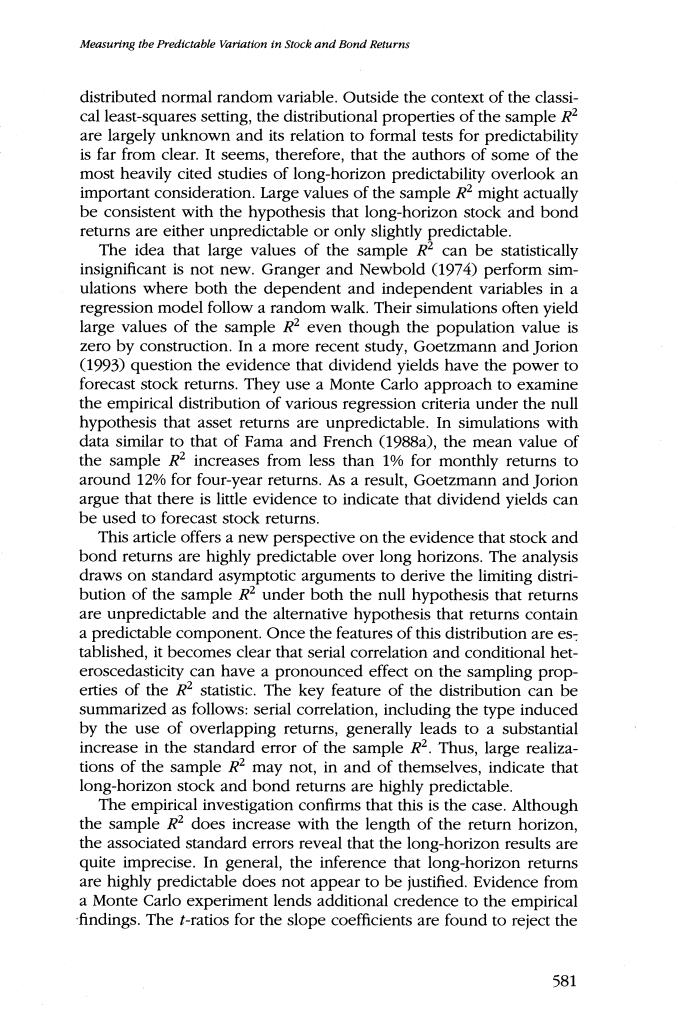
Measuring the Predictable Variation in Stock and Bond Returns distributed normal random variable.Outside the context of the classi- cal least-squares setting,the distributional properties of the sample R2 are largely unknown and its relation to formal tests for predictability is far from clear.It seems,therefore,that the authors of some of the most heavily cited studies of long-horizon predictability overlook an important consideration.Large values of the sample R2might actually be consistent with the hypothesis that long-horizon stock and bond returns are either unpredictable or only slightly predictable. The idea that large values of the sample R can be statistically insignificant is not new.Granger and Newbold(1974)perform sim- ulations where both the dependent and independent variables in a regression model follow a random walk.Their simulations often yield large values of the sample R2 even though the population value is zero by construction.In a more recent study,Goetzmann and Jorion (1993)question the evidence that dividend yields have the power to forecast stock returns.They use a Monte Carlo approach to examine the empirical distribution of various regression criteria under the null hypothesis that asset returns are unpredictable.In simulations with data similar to that of Fama and French (1988a),the mean value of the sample R2 increases from less than 1%for monthly returns to around 12%for four-year returns.As a result,Goetzmann and Jorion argue that there is little evidence to indicate that dividend yields can be used to forecast stock returns. This article offers a new perspective on the evidence that stock and bond returns are highly predictable over long horizons.The analysis draws on standard asymptotic arguments to derive the limiting distri- bution of the sample R under both the null hypothesis that returns are unpredictable and the alternative hypothesis that returns contain a predictable component.Once the features of this distribution are es- tablished,it becomes clear that serial correlation and conditional het- eroscedasticity can have a pronounced effect on the sampling prop- erties of the R2 statistic.The key feature of the distribution can be summarized as follows:serial correlation,including the type induced by the use of overlapping returns,generally leads to a substantial increase in the standard error of the sample R2.Thus,large realiza- tions of the sample R2 may not,in and of themselves,indicate that long-horizon stock and bond returns are highly predictable. The empirical investigation confirms that this is the case.Although the sample R2 does increase with the length of the return horizon, the associated standard errors reveal that the long-horizon results are quite imprecise.In general,the inference that long-horizon returns are highly predictable does not appear to be justified.Evidence from a Monte Carlo experiment lends additional credence to the empirical findings.The t-ratios for the slope coefficients are found to reject the 581
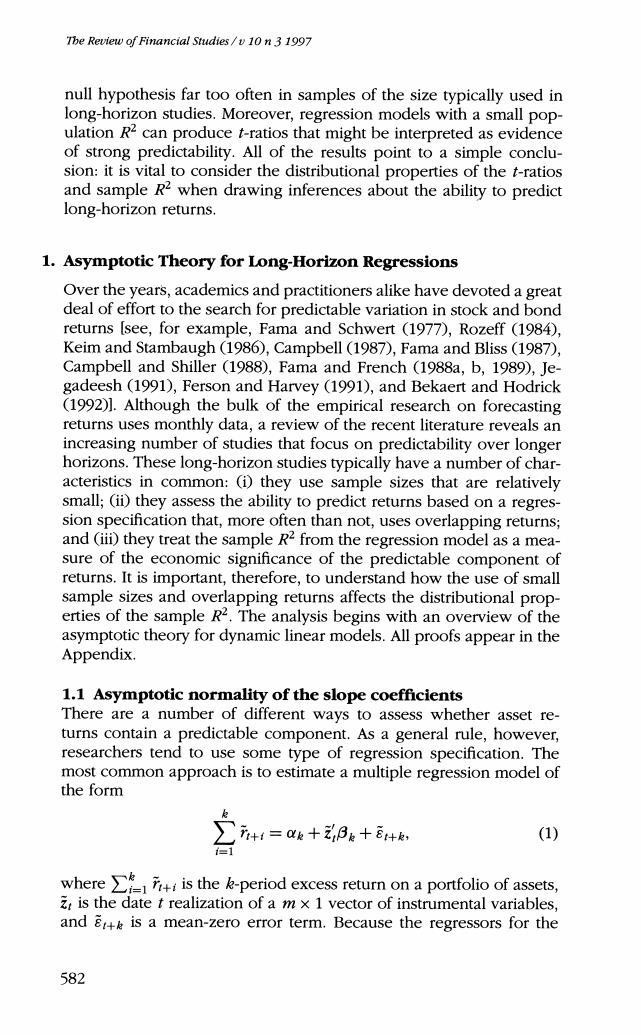
The Review of Financial Studies/v 10 n 3 1997 null hypothesis far too often in samples of the size typically used in long-horizon studies.Moreover,regression models with a small pop- ulation R2can produce t-ratios that might be interpreted as evidence of strong predictability.All of the results point to a simple conclu- sion:it is vital to consider the distributional properties of the t-ratios and sample R2 when drawing inferences about the ability to predict long-horizon returns. 1.Asymptotic Theory for Long-Horizon Regressions Over the years,academics and practitioners alike have devoted a great deal of effort to the search for predictable variation in stock and bond returns [see,for example,Fama and Schwert (1977),Rozeff (1984), Keim and Stambaugh (1986),Campbell (1987),Fama and Bliss(1987), Campbell and Shiller (1988),Fama and French (1988a,b,1989),Je- gadeesh(1991),Ferson and Harvey (1991),and Bekaert and Hodrick (1992)1.Although the bulk of the empirical research on forecasting returns uses monthly data,a review of the recent literature reveals an increasing number of studies that focus on predictability over longer horizons.These long-horizon studies typically have a number of char- acteristics in common:(i)they use sample sizes that are relatively small;(i)they assess the ability to predict returns based on a regres- sion specification that,more often than not,uses overlapping returns; and (iii)they treat the sample R2from the regression model as a mea- sure of the economic significance of the predictable component of returns.It is important,therefore,to understand how the use of small sample sizes and overlapping returns affects the distributional prop- erties of the sample R2.The analysis begins with an overview of the asymptotic theory for dynamic linear models.All proofs appear in the Appendix. 1.1 Asymptotic normality of the slope coefficients There are a number of different ways to assess whether asset re- turns contain a predictable component.As a general rule,however, researchers tend to use some type of regression specification.The most common approach is to estimate a multiple regression model of the form 元+i=十B6十8+k, (1) whereis the -period excess return ona portfolio of assets, E is the date t realization of a m x 1 vector of instrumental variables, and is a mean-zero error term.Because the regressors for the 582
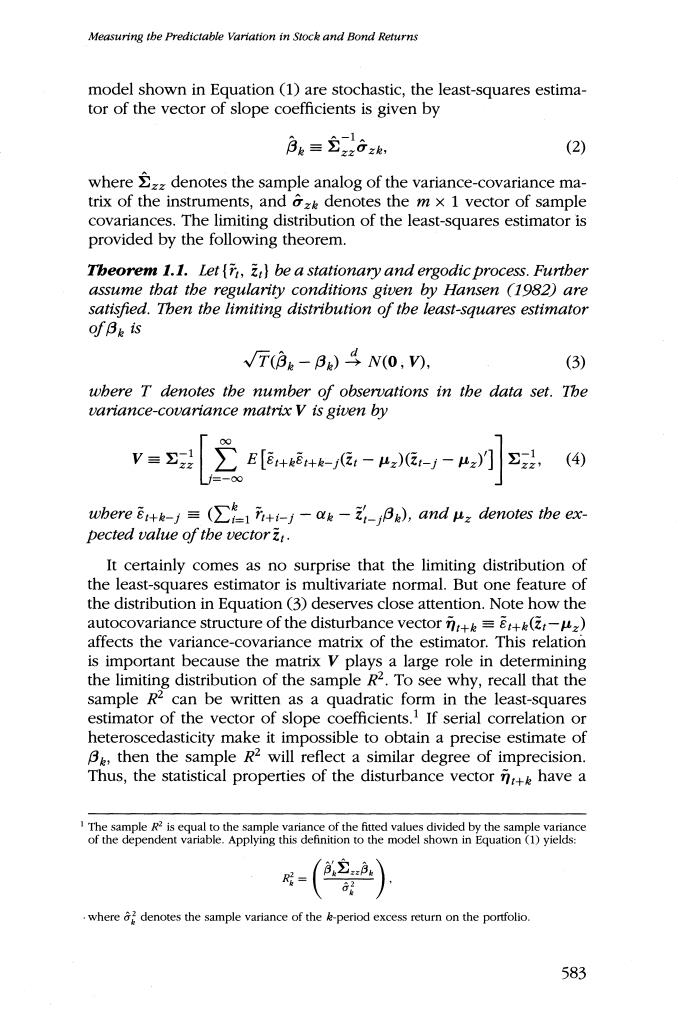
Measuring the Predictable Variation in Stock and Bond Returns model shown in Equation (1)are stochastic,the least-squares estima- tor of the vector of slope coefficients is given by ae=26, (2) wheredenotes the sample analog of the variance-covariance ma- trix of the instruments,and z denotes the m x 1 vector of sample covariances.The limiting distribution of the least-squares estimator is provided by the following theorem. Theorem 1.1.Let(n,be a stationary and ergodic process.Furtber assume that the regularity conditions given by Hansen (1982)are satisfied.Then the limiting distribution of the least-squares estimator ofF。is √T(3。-B)号N(0,V, (3) wbere T denotes the number of observations in the data set.The variance-covariance matrix V is given by 2z2 (④ wbere=(-aB),and u:denotes the ex- pected value of the vector i:. It certainly comes as no surprise that the limiting distribution of the least-squares estimator is multivariate normal.But one feature of the distribution in Equation (3)deserves close attention.Note how the autocovariance structure of the disturbance vector=(-) affects the variance-covariance matrix of the estimator.This relation is important because the matrix V plays a large role in determining the limiting distribution of the sample R2.To see why,recall that the sample R can be written as a quadratic form in the least-squares estimator of the vector of slope coefficients.If serial correlation or heteroscedasticity make it impossible to obtain a precise estimate of Ba,then the sample R2 will reflect a similar degree of imprecision. Thus,the statistical properties of the disturbance vector n+have a The sample R2 is equal to the sample variance of the fitted values divided by the sample variance of the dependent variable.Applying this definition to the model shown in Equation (1)yields: where denotes the sample variance of the k-period excess return on the portfolio. 583
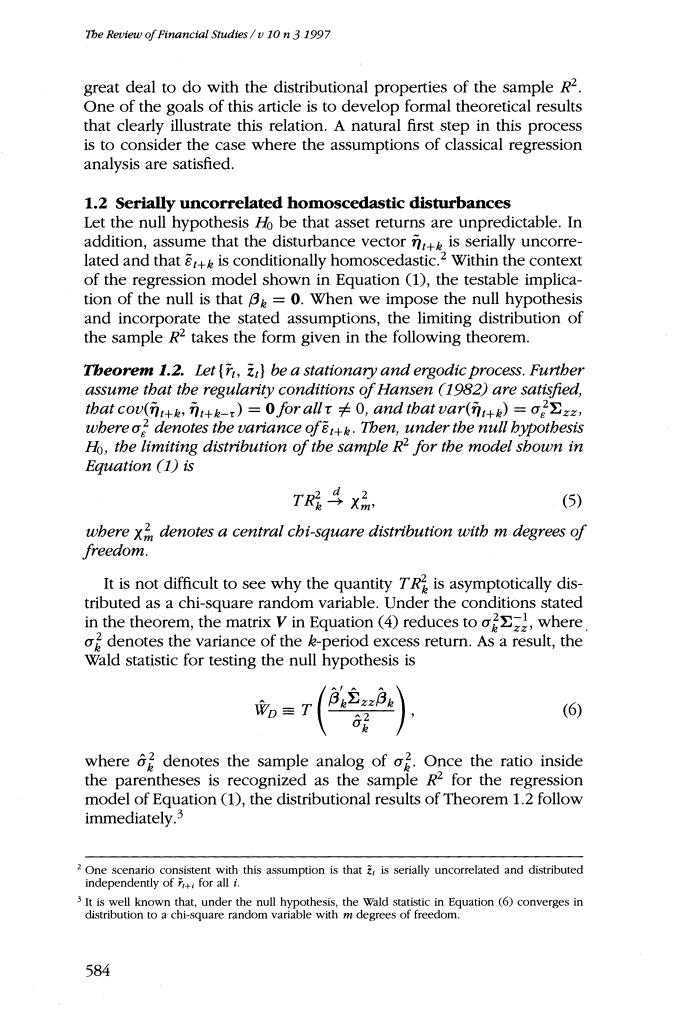
The Review of Financial Studies /v 10 n 3 1997 great deal to do with the distributional properties of the sample R2 One of the goals of this article is to develop formal theoretical results that clearly illustrate this relation.A natural first step in this process is to consider the case where the assumptions of classical regression analysis are satisfied. 1.2 Serially uncorrelated homoscedastic disturbances Let the null hypothesis Ho be that asset returns are unpredictable.In addition,assume that the disturbance vectorn is serially uncorre- lated and that is conditionally homoscedastic.2 Within the context of the regression model shown in Equation (1),the testable implica- tion of the null is that B=0.When we impose the null hypothesis and incorporate the stated assumptions,the limiting distribution of the sample R2 takes the form given in the following theorem. Tbeorem 1.2.Let (r,be a stationary and ergodic process.Furtber assume that the regularity conditions of Hansen (1982)are satisfied, that cov(n+e,i+e-t)=0 for all卡0,and that var(i+k)=o2∑zz, wbere og denotes the variance f.Then,under the null bypothesis Ho,the limiting distribution of the sample R2 for the model shown in Equation (1)is TR4X玩 (5) wbere X denotes a central cbi-square distribution with m degrees of freedom. It is not difficult to see why the quantity TR is asymptotically dis- tributed as a chi-square random variable.Under the conditions stated in the theorem,the matrix V in Equation (4)reduces to,where o denotes the variance of the k-period excess return.As a result,the Wald statistic for testing the null hypothesis is 6 (6) where 2 denotes the sample analog of o2.Once the ratio inside the parentheses is recognized as the sample R2 for the regression model of Equation (1),the distributional results of Theorem 1.2 follow immediately.3 2 One scenario consistent with this assumption is that is serially uncorrelated and distributed independently of for all i. 3 It is well known that,under the null hypothesis,the Wald statistic in Equation (6)converges in distribution to a chi-square random variable with m degrees of freedom. 584
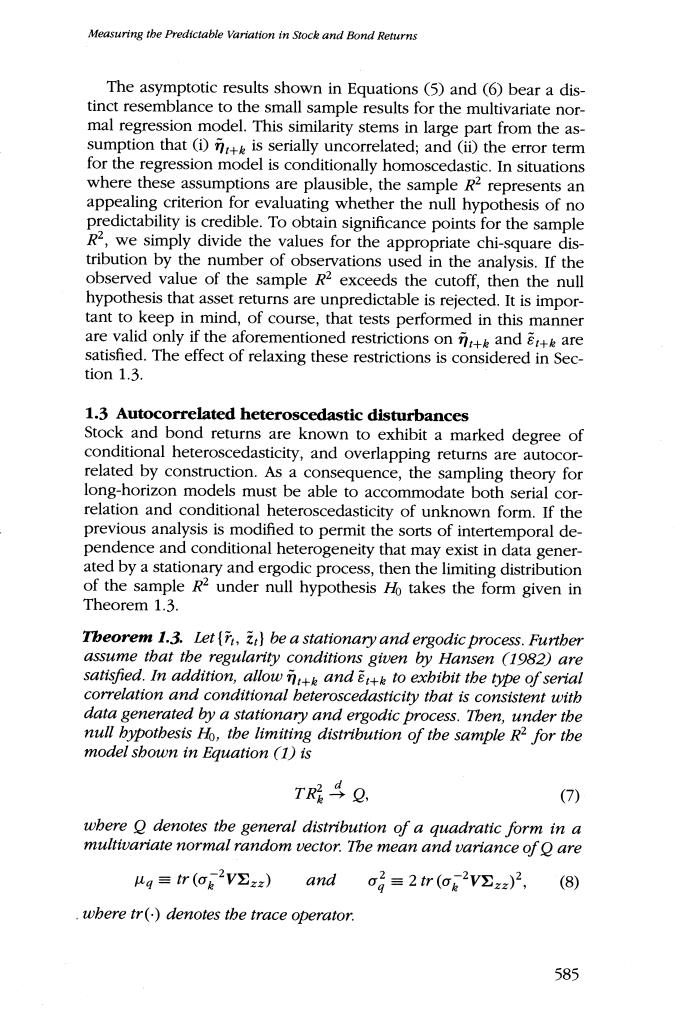
Measuring the Predictable Variation in Stock and Bond Returns The asymptotic results shown in Equations (5)and (6)bear a dis- tinct resemblance to the small sample results for the multivariate nor- mal regression model.This similarity stems in large part from the as- sumption that (i)is serially uncorrelated;and (ii)the error term for the regression model is conditionally homoscedastic.In situations where these assumptions are plausible,the sample R2 represents an appealing criterion for evaluating whether the null hypothesis of no predictability is credible.To obtain significance points for the sample R2,we simply divide the values for the appropriate chi-square dis- tribution by the number of observations used in the analysis.If the observed value of the sample R2 exceeds the cutoff,then the null hypothesis that asset returns are unpredictable is rejected.It is impor- tant to keep in mind,of course,that tests performed in this manner are valid only if the aforementioned restrictions on and are satisfied.The effect of relaxing these restrictions is considered in Sec- tion 1.3. 1.3 Autocorrelated heteroscedastic disturbances Stock and bond returns are known to exhibit a marked degree of conditional heteroscedasticity,and overlapping returns are autocor- related by construction.As a consequence,the sampling theory for long-horizon models must be able to accommodate both serial cor- relation and conditional heteroscedasticity of unknown form.If the previous analysis is modified to permit the sorts of intertemporal de- pendence and conditional heterogeneity that may exist in data gener- ated by a stationary and ergodic process,then the limiting distribution of the sample R2 under null hypothesis Ho takes the form given in Theorem 1.3. Theorem 1.3.Let (,be a stationary and ergodic process.Furtber assume that the regularity conditions given by Hansen (1982)are satisfied.In addition,allowk and to exbibit the type of serial correlation and conditional beteroscedasticity that is consistent with data generated by a stationary and ergodic process.Then,under the null bypotbesis Ho,the limiting distribution of the sample R2 for the model sbown in Equation (1)is TRQ. (7) wbere Q denotes the general distribution of a quadratic form in a multivariate normal random vector.The mean and variance of O are ug≡tr(o62V∑zz) and 0g=2r(o62V∑zz)2, (8) wbere tr()denotes the trace operator. 585
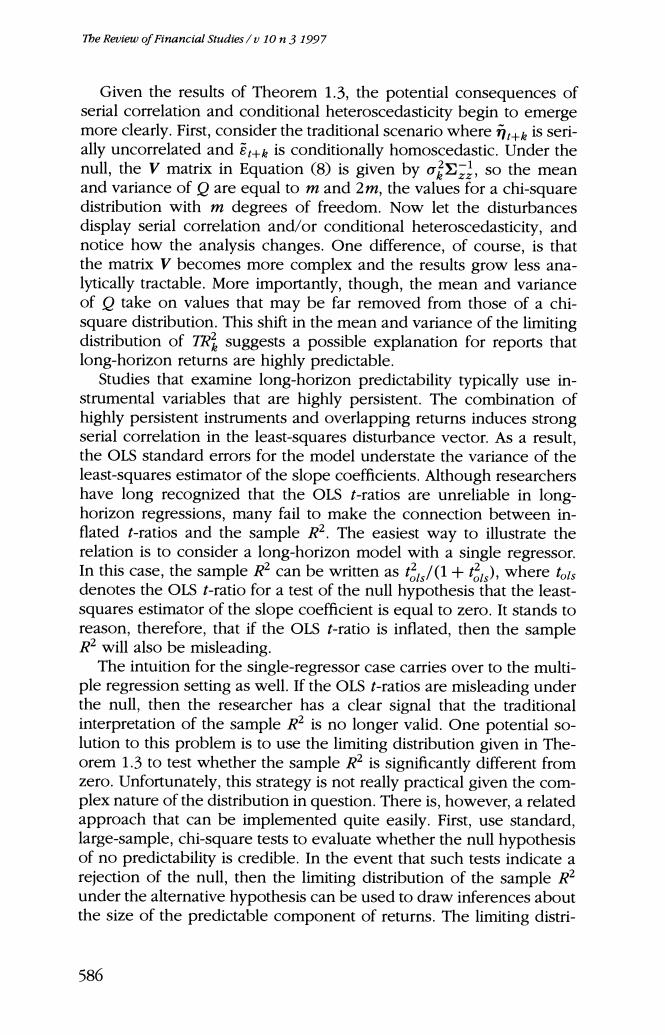
The Review of Financial Studies/v 10n 3 1997 Given the results of Theorem 1.3,the potential consequences of serial correlation and conditional heteroscedasticity begin to emerge more clearly.First,consider the traditional scenario whereis seri- ally uncorrelated and is conditionally homoscedastic.Under the null,the v matrix in Equation (8)is given by so the mean and variance of o are equal to m and 2m,the values for a chi-square distribution with m degrees of freedom.Now let the disturbances display serial correlation and/or conditional heteroscedasticity,and notice how the analysis changes.One difference,of course,is that the matrix V becomes more complex and the results grow less ana- lytically tractable.More importantly,though,the mean and variance of o take on values that may be far removed from those of a chi- square distribution.This shift in the mean and variance of the limiting distribution of TR suggests a possible explanation for reports that long-horizon returns are highly predictable. Studies that examine long-horizon predictability typically use in- strumental variables that are highly persistent.The combination of highly persistent instruments and overlapping returns induces strong serial correlation in the least-squares disturbance vector.As a result, the OLS standard errors for the model understate the variance of the least-squares estimator of the slope coefficients.Although researchers have long recognized that the OLS t-ratios are unreliable in long- horizon regressions,many fail to make the connection between in- flated t-ratios and the sample R2.The easiest way to illustrate the relation is to consider a long-horizon model with a single regressor. In this case,the sample R2 can be written asts/(1+),where tols denotes the OLS t-ratio for a test of the null hypothesis that the least- squares estimator of the slope coefficient is equal to zero.It stands to reason,therefore,that if the OLS t-ratio is inflated,then the sample R2 will also be misleading. The intuition for the single-regressor case carries over to the multi- ple regression setting as well.If the OLS t-ratios are misleading under the null,then the researcher has a clear signal that the traditional interpretation of the sample R2 is no longer valid.One potential so- lution to this problem is to use the limiting distribution given in The- orem 1.3 to test whether the sample R2is significantly different from zero.Unfortunately,this strategy is not really practical given the com- plex nature of the distribution in question.There is,however,a related approach that can be implemented quite easily.First,use standard, large-sample,chi-square tests to evaluate whether the null hypothesis of no predictability is credible.In the event that such tests indicate a rejection of the null,then the limiting distribution of the sample R under the alternative hypothesis can be used to draw inferences about the size of the predictable component of returns.The limiting distri- 586
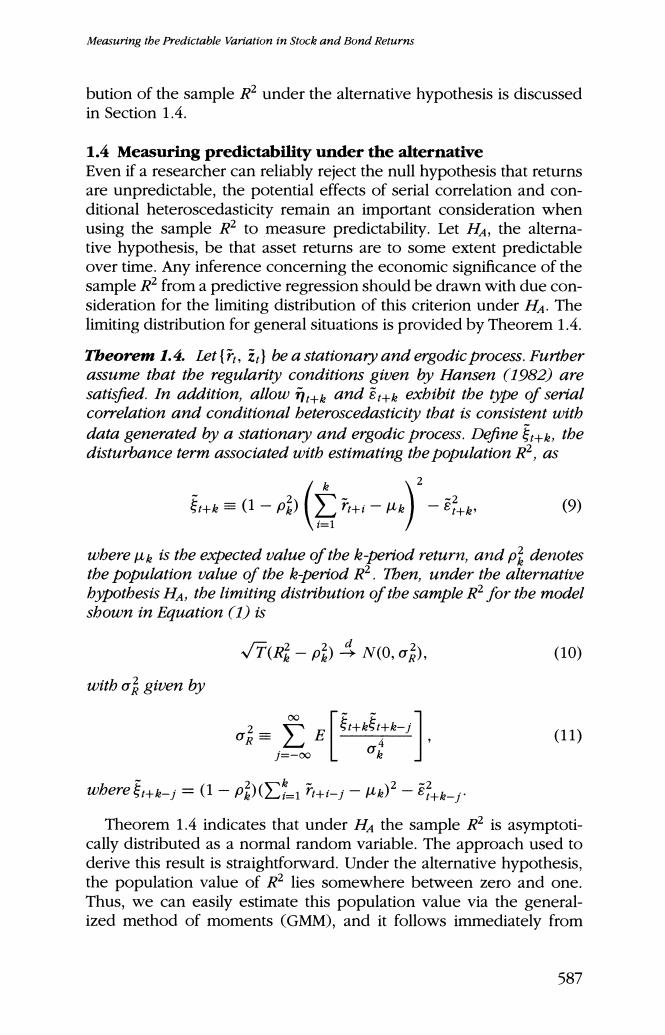
Measuring the Predictable Variation in Stock and Bond Returns bution of the sample R2 under the alternative hypothesis is discussed in Section 1.4. 1.4 Measuring predictability under the alternative Even if a researcher can reliably reject the null hypothesis that returns are unpredictable,the potential effects of serial correlation and con- ditional heteroscedasticity remain an important consideration when using the sample R2 to measure predictability.Let HA,the alterna- tive hypothesis,be that asset returns are to some extent predictable over time.Any inference concerning the economic significance of the sample R2 from a predictive regression should be drawn with due con- sideration for the limiting distribution of this criterion under H4.The limiting distribution for general situations is provided by Theorem 1.4. Tbeorem 1.4.Let(r,i)be a stationary and ergodic process.Furtber assume that the regularity conditions given by Hansen (1982)are satisfied.In addition,allowk and exbibit the type of serial correlation and conditional beteroscedasticity that is consistent with data generated by a stationary and ergodic process.Define k the disturbance term associated with estimating the population R-,as 5+≡(1-p哈) (- (9) wbere uk is the expected value of the k-period return,and pdenotes the population value of the k-period R2.Then,under the alternative bypotbesis HA,the limiting distribution of the sample R-for the model shown in Equation (1)is √T(R路-)号N0,o), (10) with o given by E (11) 0bere专+k-j=(1-p爱(∑17+i--ue)2-品+k- Theorem 1.4 indicates that under Ha the sample R2 is asymptoti- cally distributed as a normal random variable.The approach used to derive this result is straightforward.Under the alternative hypothesis, the population value of R2 lies somewhere between zero and one. Thus,we can easily estimate this population value via the general- ized method of moments (GMM),and it follows immediately from 587